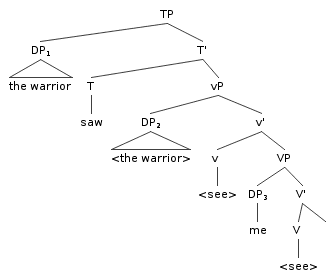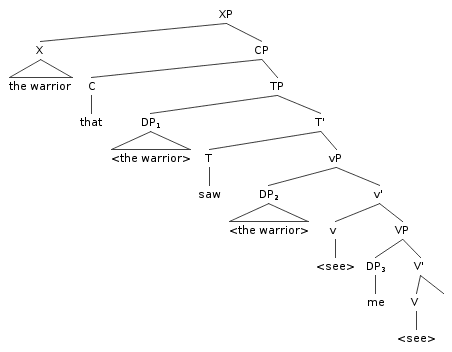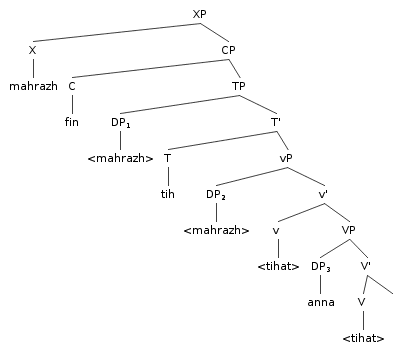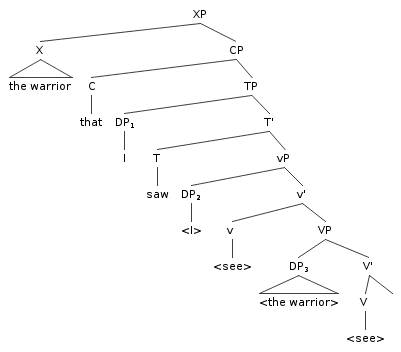Dothraki Relative Clause Structure
Autore: Caroline Elizabeth Melton
Data della SM: 09-05-2019
Data FL: 02-01-2020
Numero FL: Florida-000065-00
Citazione: Melton, Caroline Elizabeth. 2019. “Dothraki
Relative Clause Structure.” Florida-000065-00,
Fiat Lingua,
February 2020.
Diritto d'autore: © 2019 Caroline Elizabeth Melton. Questo lavoro è
concesso in licenza con un'attribuzione Creative Commons-
Non commerciale, senza derivati 3.0 Licenza non trasportata.
http://creativecommons.org/licenses/by-nc-nd/3.0/
Fiat Lingua è prodotto e gestito dalla Language Creation Society (LCS). Per maggiori informazioni
riguardo alla LCS, visita http://www.conlang.org/
Stony Brook University
Dothraki as a Naturalistic Language
Evaluating HBO’s Game of Thrones’ Dothraki Case System and Relative Clauses
using Real World Analogs and Minimalist Syntax
Caroline Elizabeth Melton
LIN Comparative Analysis
Dott. Francisco Ordoñez
18 May 2014
Melton 1
“A naturalistic language is one that attempts as nearly
as possible to imitate the quirks and idiosyncrasies of natural language.”
David Peterson on developing Dothraki, 2013
introduzione
Since the Elvish of Tolkien’s Middle Earth and the Klingon of Roddenberry’s Enterprise-traveled stars, authors and
directors have sought constructed languages (conlangs) to give their fictional universes an added element of
realism. As the Internet grows, it continues to foster intense fandom of TV shows, movies, books and other
fantasy media, these fans find it increasingly tempting to immerse themselves in the worlds they love to watch and
read about, and this includes the languages of the characters. Within the last decade, Hollywood has taken
advantage of this fervor, having employed linguists for the purpose of making languages for their actors to speak
on camera and their fans to learn. One of the most notable of these linguists is David J. Peterson, a UC San Diego-
trained linguist who was hired by HBO’s Game of Thrones to create the languages described in the show’s source,
George R.R. Martin’s A Song of Ice and Fire series, most notably Dothraki.1 While Martin’s original material was
lean, Peterson was able to create a fully usage language whose grammar he describes as “naturalistic” (“David
Peterson on developing Dothraki,” 2013). As a hobbyist who ascribes to create naturalistic languages, as a fan of
Game of Thrones, and as a student of linguistics, I am interested in objectively evaluating Dothraki as a naturalistic
lingua.
What is Naturalistic Language?
Peterson defines a naturalistic conlang as “one that attempts as nearly as possible to imitate the quirks and
idiosyncrasies of natural language.” (2013) In an attempt to find criteria with which to evaluate such behavior, an
objective analysis should start by comparing a grammar to the Universal Grammar (UG) (1a). Tuttavia, linguists do
1 Peterson has since worked on several other languages on HBO’s Game of Thrones as well as on Syfy’s Defiance and Dominion,
on CW’s Star-Crossed, and for the novel The Zaanics Deceit by Nina Post. He has been independently conlanging since 2000.
(“About David J. Peterson,” 2013).
Melton 2
not have direct access to the UG. We can use in its stead the Greenberg linguistic universals. Greenberg (1963)
proposed a list of common properties by comparing the grammars of 30 languages. Referred to as Greenberg’s
linguistic universals, they number 1-45 and reflect what Greenberg hypothesized to be rules that natural language
cannot violate. For a more general evaluation, we might aim to compare the conlang to natural languages (1b) con
the conclusion that a natural language cannot exhibit behavior that violates the UG.
(1) A naturalistic conlang is one
UN.
that obeys the Universal Grammar (UG).
b. whose behavior has analogs in natural language.
In studying natural languages, data can be acquired from real speakers, native or otherwise. While there are
speakers of Dothraki, they would be neither native speakers nor undeniably fluent and thus, that cannot be collected
in the same manner as a natural and living language. Fans of TV shows, book, and other media use the canon
convention in such circumstances. Information about storylines, storie, characters, and conlangs that is derived
from the original work is considered canon (short for canonical),2 and conversely fan-made derivations and official
but peripheral works (per esempio. fan-written work and some movie tie-ins) are not canon. In place of real-world data, IO
have adopted this convention where the relevant canon is what has been released by HBO’s Game of Thrones or
Peterson himself (via his blog Dothraki.com) as official. Only canonical Dothraki with be discussed in the analysis.
Gender, Number, and Case Systems
Dothraki nouns have one of two genders: animate and inanimate. While a noun’s gender can sometimes correlate
with grammatical animacy, this is not a reliable indicator. Per esempio, while the animacy of ave ‘father’ and chifti
‘locust’ might be predicted, chiorikem ‘wife’ and hrazef ‘horse’ are inanimate. Although vizhadi ‘silver’ is inanimate,
so is mawizzi ‘rabbit’. As with natural language gender, the animate/inanimate distinction is lexical and not driven
by semantics. Gender affects the inflection the noun will take, where animate nouns inflect for case3 and number,
2 This convention derives from Biblical canon: the distinction between the books of the Bible commonly considered
sacro (the canon) and those that are attested to be false, misleading, or fraudulent (the Apocrypha).
3 The five cases in Dothraki are Nominative, Accusative, Genitive, Allative, and Ablative. These are discussed
further below.
but inanimate nouns only inflect for case (2). All adjectives, regardless of the gender of the noun they modify, inflect
for both case and number (3).
(2) The noun inflectional paradigms for verak ‘traveler’ and olta ‘hill.’ (Adapted from “Dothraki 101,” Peterson.)
Melton 3
Animate
Inanimate
Singolare
Nominative
verak
Plural
veraki
Accusative
verakes
verakis
Genitive
veraki
Allative
verakoon
verakea
–
olta
olt
olti
oltaan
Ablative
verakoon
verakoa
oltoon
(3) The adjective inflectional paradigm for ivezh ‘wild.’ (Adapted from “Dothraki 101,” Peterson.)
Animate and Inanimate
Singolare
ivezh
ivezha
Plural
ivezhi
Nominative
Accusative
Genitive
Allative
Ablative
Personal pronouns (4) reflect three persons and two numbers (singular and plural), which is consistent with
Greenberg’s 42nd linguistic universal (5). The second person have both familiar and formal forms, where the formal
form does not change depending on number. All of the personal pronouns inflect for cases.
(4) The personal pronoun inflectional paradigm. (Adapted from “Dothraki 101,” Peterson.)
First Person
Second Person
Third Person
Familiar
Formal
Singolare
Plural
Singular Plural
Singular and Plural
Singolare
Plural
Nominative
Accusative
Genitive
anha
anna
anni
kisha
kisha
kishi
yer
yera
yeri
yeri
yeri
Allative
anhaan
kishaan
yeraan
yerea
Ablative
anhoon
kishoon
yeroon
yeroa
shafka
shafka
shafki
shafkea
shafkoa
Me
mae
mae
maan
luna
mori
mora
mori
morea
moroa
Melton 4
(5) Greenberg’s 42nd Linguistic Universal. (Greenberg, 1963.)
42. “All languages have pronominal categories involving at least three persons and two numbers.”
There is gender distinction in the third person singular; nominative 3rd person singular me is used for both animate
and inanimate antecendents. This is a violation of Greenberg’s 43rd linguistic universal, which states that
languages maintain a hierarchy of gender distinctions in nominals (6).
(6) Greenberg’s 43rd Linguistic Universal. (Greenberg, 1963.)
43. “If a language has gender categories in the noun, it has gender categories in the pronoun.”
Dothraki nominals inflect for five cases: nominative, accusative, genitive, allative, and ablative. Nominative is
assigned to the subjects of independent clauses (7a). Accusative is generally given to objects (7b), genitive to
possessors of nominals (7c), allative generally to thematic goals (7d), and ablative generally to thematic origins (7e).
(7) Nouns inflected for the five Dothaki cases. (Adapted from “Athchomar Chomakea!,” Peterson 2012.)
UN.
Jan-o
dog-NOM.INA
‘The dog bit the horse.’
hrazef
ost
bite[PST] horse[ACC.INA]
b. Hrazef
horse[NOM.INA]
‘The horse bit the dog.’
ost
jan
bite[PST] dog[ACC. INA]
c.
d.
e.
lajak-i
Jan-o
warrior-GEN.ANI
dog-NOM. INA
‘The warrior’s dog bit the horse.’
hrazef
ost
bite[PST] horse[ACC.INA]
jad-aki
Kisha
1[PL.NOM] come-1PL.PRES
‘We come from the mountain(s).’
krazaaj-oon
mountain-ABL.INA
Kisha ver-aki
1[PL.NOM] travel-1PL.PRES
‘We are traveling to the mountain(s).’
krazaaj-aan
mountain-ALL.INA
Nell'esempio (7) Sopra, the nominative jano ‘dog’ has a morpheme that the accusative jan ‘dog’ does not. IL
nominative appears to carry inflection while the accusative has a null inflection. This is true for all accusative
Melton 5
inanimate nouns (as seen in 2 above). This paradigm violates Greenberg’s 38th linguistic universal (8) which notes
that if case systems have null case markers, they mark the nominative case.
(8) Greenberg’s 38th Linguistic Universal. (Greenberg, 1963.)
38. “Where there is a case system, the only case which ever has only zero allomorphs is the one which
includes among its meanings that of the subject of the intransitive verb.”
The Dothraki case system itself (nominative, accusative, genitive, allative, and ablative) appears to violate a tendency
noted by Blake (1994) where languages maintain a hierarchy of case (9). Dothraki has no dative case yet it has
ablative. It has no instrumental or vocative, yet has the allative. Either Dothraki does not follow this hierarchy and
is not naturalistic, or its existing cases are mislabeled and really behave more the conventional dative and
locative/prepositional cases.
(9) Blake’s Hierarchy of Case. (Blake, 1994.)
Nominative à accusative/ergative à genitive à dative à locative/prepositional à ablative à
instrumental à vocative à others
Syntax of Case-Marked Relative Clauses
Relative clause formation offers many cross-linguistic variations. Most languages can relativize the subject of a
clause, fewer can relative the object, and still fewer can relativize other relations to the verb like thematic
instruments, goals and origins. English allows relativizations on all of these structures (10).
(10) English Relative Clause Structures.
Nominative/subject
‘The dog that bit the horse’
Accusative/object
‘The dog that the horse bit’
Genitive/possessor
‘The warrior whose dog bit the horse’
Allative/goal
‘The mountain that we travel to’
Ablative/origin
‘The mountain that we come from’
Melton 6
English relative clauses move the noun being relativized and the remaining information usually retains the order of
the independent clauses. The same is true in Dothraki (11), whose independent clause structure is SVO like English
(12). The result is that Dothraki relative clauses have a structure that looks like English (13). The subject of the
relative clause moves first to spec of TP and then out of the relative clause and into the head of the commanding
phrase. This internal movement is consistent with the independent clause structure as should be expected (14). IL
movement out of the phrase triggers nominal marking on the clause relativizer fin ‘that/which’ which allows the
subject which has been relative to bare the case it receives in the matrix clause.
(11) An independent clause Dothraki. (Adapted from “Relative Clauses in Dothraki,” Peterson 2011.)
Mahrazh
warrior[NOM.ANI]
‘The warrior saw me.’
anna
tih
Vedere[PST] 1[SG.ACC]
(12) Independent clause structure in English and Dothraki. (Adapted from “Relative Clauses in Dothraki,”
Peterson 2011.)
‘The warrior saw me’
(13) A subject relative clause in Dothraki. (Adapted from “Relative Clauses in Dothraki,” Peterson 2011.)
Mahrazh
warrior[ANI]
‘The warrior that saw me’
fin
Quello[SG.NOM.ANI]
anna
tih
Vedere[PST] 1[SG.ACC]
(14) Subject (nominative) relativization in English and Dothraki. (Adapted from “Relative Clauses in Dothraki,”
Peterson 2011.)
‘The warrior that saw me’
Melton 7
Accusative-marked objects may be relativized in English. Così facendo, the internal structure of the relative clause
remains in place and only the object moves out into the matrix clause (15). Both the relative clause and the matrix
clause orders remain SVO.
(15) Oggetto (accusative) relativization in English.
‘The warrior that I saw’
In the fictional history of the Dothraki language, historical Dothraki was VSO. As it changed to a SVO structure in the
independent clauses, it retained the historical VSO structure in the relative clauses (“Relative Clauses in Dothraki,”
2011). Di conseguenza, when objects are relativized, the clause structure is different from that of the subject structure
Melton 8
(16) and its movement is inconsistent with minimalist syntactic structures. Such a system where movement in an
independent clause results in SVO order but within the relative clause, either the subject’s movement is restricted
(17a) or the verb is forced to move to a spec of XP between CP and TP (17b) is has no know analog in natural language.
The behavior can therefore be considered unnaturalistic.
(16) A subject relative clause in Dothraki. (Adapted from “Relative Clauses in Dothraki,” Peterson 2011.)
Mahrazh
warrior[ANI]
‘The warrior that I saw’
multe
Quello[SG.ACC.ANI]
anha
tih
Vedere[PST] 1[SG.NOM]
(17) Two hypotheses of object (accusative) relativization in Dothraki. The leftmost tree (UN) disallows internal
movement of the subject of the relative clause to spec of TP. The rightmost tree (b) forces the verb of the
relative clause to move up from T to somewhere between CP and TP. (Adapted from “Relative Clauses in
Dothraki,”Peterson 2011.)
‘The warrior that I saw’
(UN)
(b)
What happens within these Dothraki object relativizations also happens with genitive, allative, and ablative
structures (18).
(18) Genitive, allative, and ablative relative clauses in Dothraki. (Adapted from “Relative Clauses in Dothraki,”
Melton 9
Peterson 2011.)
UN. Mahrazh
fini
Quello[SG.GEN.ANI]
warrior[ANI]
‘The warrior whose arakh I saw’
anha
tih
Vedere[PST] 1[SG.NOM] arakh[ACC.INA]
arakh4
b. Mahrazh
warrior[ANI]
‘The warrior who I gave an arakh to’
finnaan
Quello[SG.ALL.ANI]
anha
azh
give[PST] 1[SG.NOM] arakh[ACC.INA]
arakh
c. Mahrazh
warrior[ANI]
‘The warrior who I am stronger than’
finnoon
Quello[SG.ABL.ANI]
ahajanak
forte[COMP]
anha
1[SG.NOM]
Conclusione
The gender, numero, and case systems of Dothraki have some analogs in natural language, but also break some
universal rules as stated by Greenberg (1963) e altri. Dothraki relative clause structures break universals that
minimalist syntax cannot represent. While Peterson explains these violations within the fictional history of the
lingua, they have no correspondence in natural language and lead me to conclude that Dothraki is, at least in
someways, unnaturalistic. While no one should fault Peterson for taking artistic license in creating a language
which will really only have life in a fictional universe, I maintain that calling it a naturalistic conlang is a valid
statement.
4 An arakh is a curved sword which has no English name.
Melton 10
Riferimenti
Blake, Barry J. “Case.” Cambridge: Pressa dell'Università di Cambridge. 1994.
“David Peterson on developing Dothraki” www.ed.ted.com. ragnatela. 8 May 2014.
Greenberg, Joseph. “Some Universals of Grammar with Particular Reference to the Order of Meaningful
Elements.” Universals of Language (1963): 110-13.
Peterson, Davide. “About David J. Peterson.” Dothraki: A Language of Fire and Blood. 28 March 2013.
Dothraki.com. ragnatela. 8 May 2014.
Peterson, Davide. “Athchomar Chomakea!” Dothraki: A Language of Fire and Blood. Dothraki.com. 14 September
2012. ragnatela. 17 May 2014.
Peterson, Davide. “Dothraki 101.” Dothraki: A Language of Fire and Blood. Dothraki.com. ragnatela. 17 May 2014.
Peterson, Davide. “Relative Clauses in Dothraki.” Dothraki: A Language of Fire and Blood. Dothraki.com. 13 October
2011. ragnatela. 8 May 2014.







